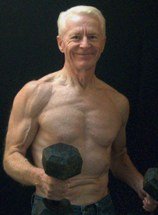


In today's Oct. 1, 2011 newsletter . . .
Will You Inspire Others?We weren't designed for flat-screen TV watching or Internet surfing, wonderful as those inventions may be. We weren't designed either to eat every day the equivalent of a holiday feast. Too much sitting and too much eating is why Americans and those of other advanced nations are getting fatter every year.It is human nature to seek leisure, comfort and ease. Yet we were designed to fish, hunt, forage, move, and do physical labor. Lots of it. Our computers, high-definition TVs, and frequent over-sized meals work against us. Modern toys and tools are not going to go away. And some will even argue that if they are so bad, why do most people today live longer than people did before we had them? It's a softball question. Modern sanitation, vaccinations, and phenomenal medical advances are the reasons people live longer. The bad side is that super-sized meals and sofa-slouching threaten to negate the medical advances that have extended our lives. "Threaten" is the wrong word though. In fact it is already happening. Doctors say that today's youth may be the first generation to have shorter lifespans than the previous generation. Early onset of diseases spawned by fatness and obesity is the reason. Reading this now probably means that you, personally, take care of yourself. More than likely, you set an example others should follow. Suppose your example were to convince someone else to begin living a fitness lifestyle. It happens. So why not spread the word? Visit "Your Stories" and see what I mean. Scroll down the "Your Stories" page and read about other inspirational people like you. The building blocks section at the top of page make sharing your experiences simple to do. Internet or publishing know-how aren't necessary. No one knows your story better than you. I hope you'll tell it. Visit "Your Stories" here. Workout Variety: Push/Pull LaddersHere's a routine guaranteed to increase your ability to do pull-ups (or chin-ups) and pushups. At the same time, it is quick and covers almost total upper body.For my example here, let's assume your maximum for a single set of pull-ups or chin-ups is 6 repetitions. And for pushups, let's say it is 20. What you do is superset the two movements in an escalating ladder. Now, the key point to remember is that it is going to be a sub-maximal effort. In other words, you do not go to failure on any set. The idea is to increase your pull-up and pushup volume. And it won't work if you do reps to failure. Burnout usually follows and your progress stalls. Sub-maximal ladders practiced consistently work far better. Start by doing 1 pull-up. Now imagine you have a training partner (if you don't actually have one), and he or she does 1 rep. That's the right amount of rest you need. Don't rush. But don't linger, either. So when your workout partner completes the rep, you do four pushups. Now your partner does four. Next, you do 2 pull-ups. Your partner follows with 2. Your ladder looks like the following:
Instead, begin at 1 rep and start a new ladder. Once again, stop when you reach that point when 1 or 2 reps would still be possible. It doesn't matter where you are on the ladder. As soon as you reach that point, stop. If the ladders are done in sequence, that is, back-to-back, stop when you cannot complete the same number of sets that you did in the first ladder. That is the key. Your ladder workout is finished. And do not do more upper body work. Do your ladders 3 times per week with at least 1 day of rest between sessions. If you are doing only 1 ladder at a time, you can do them 2 or 3 times per day, if they are done several hours apart. But be sure to rest one day before your next workout. The important thing is to not exhaust yourself at any time. Your objective is sheer volume. Suppose that you finish 4 complete sets of ladders (as in the example) in one session. You will have done 40 pull-ups and 112 pushups. Round out your workout with some leg and core (low back and abs) work and you are finished. Do not do more upper-body work. Do the ladders for a few weeks or a month and then test yourself for how many consecutive pull-ups and pushups you can do. I think you'll be surprised and pleased. Notes:
You've probably heard about the tremendous benefits of weight training and how you can retain -- or even reclaim -- the attributes of youth . . . Discover the way with . . . Gray Iron: A Fitness Guide for Senior Men and Women Newsletter Policy The Gray Iron Fitness Newsletter is a free publication sent twice monthly to subscribers. The purpose is to provide honest and realistic fitness information for people age 50 and above. I have never been paid or received compensation of any kind to write a positive review or endorse a product. If I say that I personally use a product or service, it is because I find value in it and have paid for it with my own money. Like newspapers, magazines and television, this newsletter and my web site contain advertising and marketing links. Naturally, I am compensated for these. The newsletter and web site provide information to help users establish and maintain a fitness lifestyle. But fitness information is not the same as fitness advice, which is the application of exercise and dietary practices to an individual's specific circumstances. Therefore, always consult with your physician for assurance that fitness information, and your interpretation of it, is appropriate for you. Your comments and questions are always appreciated. Sincerely, Logan Franklin The Gray Iron Fitness Newsletter www.senior-exercise-central.com |